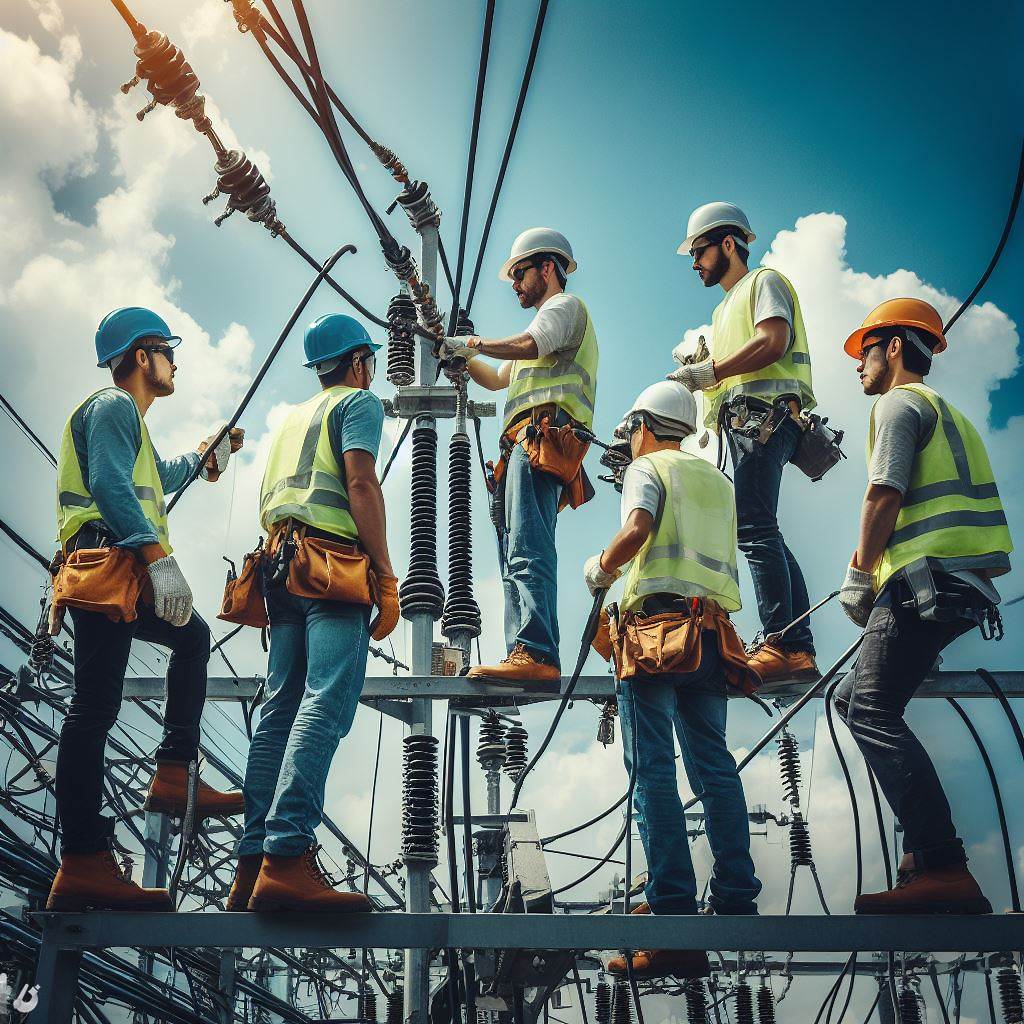Introduction
A. Importance of Safety in the Electrical Industry
Safety is paramount in the dynamic realm of electrical work.
Electricians navigate a high-risk landscape daily, demanding vigilance.
B. Common Hazards Electricians Face Daily
- Electrocution: A constant threat, handling live wires demands precision.
- Falls: Working at heights poses risks; proper equipment is non-negotiable.
- Burns: Intense heat from equipment can cause severe injuries.
- Arc Flashes: Sudden discharges of energy require protective gear for prevention.
- Repetitive Strain Injuries: Prolonged tasks can strain muscles; ergonomic practices are crucial.
- Chemical Exposure: Dealing with substances demands knowledge and protective measures.
- Confined Spaces: Tight spots amplify risks; awareness and precautionary measures are essential.
This section aims to explore these hazards in-depth, providing insights into mitigation strategies and emphasizing the imperative—safety first, always.
Electrical Shock
A. Definition and causes of electrical shock
Electrical shock is the physiological reaction caused by the flow of electric current through the body.
It occurs when a person comes into contact with an energized electrical source or conductive object.
B. Potential injuries and consequences of electrical shock
Electrical shock can lead to various injuries, ranging from minor burns and muscle contractions to severe electrical burns, nerve damage, respiratory distress, and even cardiac arrest.
It can also result in permanent disability or death.
C. Safety measures to prevent electrical shock
1. Proper use of personal protective equipment (PPE)
Electricians should always wear appropriate PPE, such as insulated gloves, safety glasses, and footwear, to minimize the risk of electrical shock.
PPE provides a barrier between the body and the electric current.
2. Safe work practices and procedures
Adhering to safe work practices, such as de-energizing electrical systems before performing any maintenance or repairs, using lockout/tagout procedures, and avoiding shortcuts, can significantly reduce the occurrence of electrical shock accidents.
3. Ground fault circuit interrupters (GFCIs) and electrical insulation
GFCIs are essential safety devices that quickly detect abnormal electric current flow and shut off the power supply.
It is crucial to install GFCIs in areas where water and electricity may come into contact.
Additionally, electrical insulation helps protect against electric shock by preventing direct contact with energized parts.
4. Conducting regular inspections and maintenance of electrical equipment
Regular inspections and maintenance of electrical equipment, such as outlets, switches, and cords, can help identify potential hazards like frayed wires or loose connections.
Timely repairs or replacements can prevent electrical shocks caused by faulty equipment.
By prioritizing these safety measures, electricians can significantly reduce the risk of electrical shock incidents during their daily work.
Read: Evolving Tech Trends: Electricians in the Digital Age
Arc Flash and Arc Blast
A. Definition and differences between arc flash and arc blast
Arc flash and arc blast are hazardous electrical events that can cause severe injuries and even fatalities.
It is important to understand the differences between the two.
Arc flash is an explosion caused by a sudden release of energy due to an electrical fault.
Transform Your Career Today
Unlock a personalized career strategy that drives real results. Get tailored advice and a roadmap designed just for you.
Start NowIt creates an intense flash of light and heat, releasing a destructive amount of thermal energy.
On the other hand, arc blast refers to the pressure wave generated by the rapid expansion of high-temperature air during an arc flash.
It can cause substantial damage and injury due to the blast effect.
B. Potential injuries and consequences of arc flash and arc blast
The potential injuries from arc flash and arc blast are numerous and severe.
Electricians may experience burns, both thermal and electrical, which can result in permanent disfigurement and disability.
They can also suffer from electrical shock, hearing loss, and eye injuries due to the intense light and heat produced during the event. Some accidents may even lead to fatal outcomes.
C. Safety measures to prevent arc flash and arc blast
1. Adhering to proper lockout/tagout procedures
To prevent arc flash and arc blast incidents, several safety measures need to be implemented.
Adhering to proper lockout/tagout procedures is crucial as it ensures that electrical systems are de-energized and secured before any work is performed.
This greatly reduces the risk of accidental exposure to live electrical components.
2. Using appropriate electrical tools and equipment
Using appropriate tools and equipment is equally vital.
Regular inspection of tools and adherence to voltage ratings help prevent failures and malfunctions during work.
Insulated tools and PPE provide an added layer of protection in case of an arc flash incident.
3. Creating and maintaining safe working distances
Creating and maintaining safe working distances play a significant role in mitigating the risks of arc flash and arc blast.
Marking restricted approach and flash boundaries, as well as using barriers and warning signs, helps in preventing accidental contact with energized equipment.
4. Providing adequate training and awareness about arc flash hazards
Proper training and awareness about arc flash hazards are essential for every electrician.
They should be able to identify potential risks and know the appropriate actions to take when working in hazardous environments.
Continual education and regular safety meetings help reinforce their understanding and commitment to safety.
In a nutshell, preventing arc flash and arc blast incidents requires a combination of safety measures such as adhering to lockout/tagout procedures, using appropriate tools, maintaining safe distances, and providing proper training.
By prioritizing safety and implementing these measures, electricians can effectively reduce the risks associated with these hazardous events.
Showcase Your Business Today
Reach thousands of readers actively exploring professional services. Publish your business profile and grow your audience now.
Publish NowRead: Electrician Licensing: State by State Requirements

Discover More: Emerging Technologies in Welding: US Industry’s Adaptation
Falls and Working at Heights
It is crucial for electricians to prioritize safety while working at heights.
Falls from elevated locations can lead to devastating injuries and even fatalities.
By implementing the necessary safety measures, electricians can significantly reduce the risk of falls and ensure their well-being.
A. Risks associated with working at heights
Working at heights comes with inherent risks, such as instability, unprotected edges, and the potential for equipment failure.
Electricians must be aware of these hazards and take appropriate precautions to mitigate them.
B. Safety measures to prevent falls and injuries while working at heights
1. Utilizing fall protection systems
One of the most effective ways to prevent falls is by utilizing fall protection systems.
Electricians should always wear a harness and attach themselves to a secure anchor point when working at heights.
Safety nets and guardrails should also be installed in areas where falls are likely to occur.
2. Inspecting and maintaining ladders, scaffolds, and other access equipment
Regular inspection and maintenance of ladders, scaffolds, and other access equipment are critical to ensure their stability and reliability.
Electricians should thoroughly check for any defects, such as loose rungs, damaged components, or corrosion, before using these structures.
Additionally, proper training on ladder and scaffold usage is essential to prevent accidents.
3. Implementing proper techniques for safe climbing and descending
Safe climbing and descending techniques are crucial for electricians working at heights.
They should always maintain three points of contact on the ladder or scaffold, ensuring stability and balance.
Using sturdy footholds and avoiding sudden movements can further reduce the risk of slips and falls.
4. Conducting thorough risk assessments and planning work accordingly
Before starting any task, electricians should conduct thorough risk assessments.
This process involves identifying potential hazards, evaluating their severity and likelihood, and implementing appropriate control measures.
By planning work accordingly and considering factors such as weather conditions, workload, and emergency procedures, electricians can minimize the risk of falls and other accidents.
Most importantly, falls and working at heights pose significant risks to electricians.
However, by implementing safety measures such as utilizing fall protection systems, inspecting and maintaining access equipment, following proper climbing techniques, and conducting thorough risk assessments, electricians can ensure their safety while working at elevated locations.
Prioritizing safety is crucial in minimizing the potential injuries and consequences of falls in the electrical profession.
Read: Union vs. Non-Union Electricians: What’s the Difference?
Electrical Burn and Fires
A. Causes and types of electrical burns
Electrical burns can occur due to direct contact with live wires or faulty electrical equipment.
These burns can be superficial or deep, leading to severe tissue damage and potential amputation.
Arc burns result from electrical arcing and can cause extensive tissue destruction.
Thermal burns occur when an electrical source ignites flammable materials or clothing.
B. Dangers of electrical fires and their potential consequences
Electrical fires can spread rapidly, causing significant damage to property and jeopardizing lives.
They can result in smoke inhalation, leading to breathing problems, lung damage, and even death.
Electrical fires can cause power outages, disrupting daily activities and affecting businesses.
The release of toxic gases during electrical fires can pose serious health risks to occupants.
C. Safety measures to prevent electrical burns and fires
Proper handling and installation of electrical components are crucial to prevent electrical burns.
Electricians should ensure that wiring is properly insulated and secured to minimize the risk of electrical fires.
Regular inspection of electrical systems can help identify potential hazards and rectify them promptly.
Implementing appropriate fire safety measures, such as installing smoke detectors and fire alarms, is essential.
Having fire extinguishers readily available in case of electrical fires can help mitigate the damage.
Ensuring that electrical systems comply with current codes and regulations minimizes the risk of fires.
Overall, electrical burns and fires pose significant hazards to both electricians and the general public.
Understanding the causes and types of electrical burns is crucial in implementing preventive measures.
Proper handling, installation, and regular inspection of electrical systems are essential to prevent burns and identify potential hazards.
Showcase Your Business Today
Reach thousands of readers actively exploring professional services. Publish your business profile and grow your audience now.
Publish NowAdditionally, implementing fire safety measures, such as having fire extinguishers readily available, can help reduce the consequences of electrical fires.
Complying with current codes and regulations ensures the overall safety and reduces the risk of electrical fires.
Read: Top Cities for Electricians: Where to Earn the Most
Conclusion
A. Recap of Common Hazards for Electricians
- Electric Shock: A constant threat in handling live wires and circuits.
- Falls: Working at heights poses risks of serious injuries.
- Burns: Exposure to hot surfaces and equipment can cause severe burns.
- Arc Flashes: Sudden releases of energy can be life-threatening.
- Repetitive Strain Injuries: Cumulative stress from repetitive tasks can impact health.
B. Importance of Prioritizing Safety in the Electrical Profession
Safety isn’t just a priority; it’s a responsibility. The electrical profession demands constant vigilance to prevent accidents and protect lives.
C. Encouragement to Continuously Learn and Stay Updated on Safety Standards
Embrace a culture of continuous learning. Stay abreast of evolving safety standards and practices.
Your commitment to staying informed enhances not only your safety but that of your colleagues.
Electrical work is dynamic, and so should be your approach to safety.
[E-Books for Sale]
The Big Book of 500 High-Paying Jobs in America: Unlock Your Earning Potential
$19.99 • 500 High-Paying Jobs • 330 pages
Explore 500 high-paying jobs in America and learn how to boost your career, earn more, and achieve success!
See All 500 High-Paying Jobs of this E-Book
1001 Professions Without a Degree: High-Paying American Jobs You Can Start Now
$19.99 • 1001 Professions Without a Degree • 174 pages
Discover 1001 high-paying jobs without a degree! Unlock career tips, skills, and success strategies for just $19.99!




